Are you interested in starting a saltwater aquarium but not sure where to start or what fish to get? In this post, we’ll explain the 20 best saltwater aquarium fish for beginners.
Most of the time, the best saltwater fish for beginners include:
- Inexpensive varieties
- Hardy fish such as a Damselfish, Clownfish, and Chromis
- Varieties that don’t need a large tank
We’ll get into the list of the most popular saltwater aquarium fish for beginners and afterward, we’ll give you more information on methods of adding fish to your aquarium.
If you are ready to get started, learn more about our available aquariums, our saltwater fish for sale, and how to set up your saltwater aquarium.
Table of Contents
20 Best Saltwater Aquarium Fish
You’ve most likely heard that a saltwater aquarium is more difficult to keep than a freshwater aquarium. It is true that keeping the tank clean and water balanced does take a bit more work and dedication.
However, you can make it a little easier on yourself by choosing to fill your tank with the best saltwater aquarium fish, having the right supplies and the right tank.
If you’re just getting into keeping saltwater fish, here are some of the best varieties.
1. Clownfish
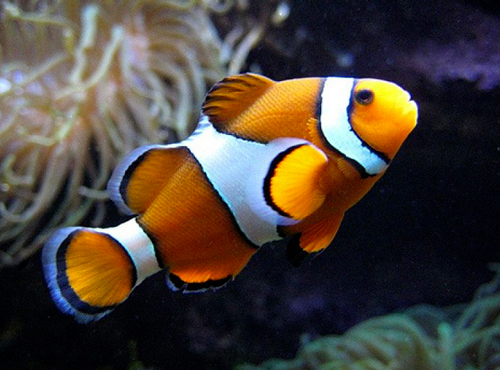
- Quick Info: Very hardy, easy to keep
- Scientific Name: Amphiprioninae
- Care Level: Easy
- Minimum Tank Size: 20 gallons
- Diet: Omnivore
- Temperament: Peaceful
The Clownfish is one of the most popular saltwater fish today; probably in no small part due to the Disney movie Finding Nemo.
You may remember that Nemo was a Clownfish, and if you’ve been hoping to add one to your saltwater tank, you’re in luck. Clownfish (especially the tank raised variety) are easy to care for. Being one of the most popular saltwater fish, food for it is easy to find.
Tank raised Ocellaris Clownfish are hardy and more colorful than the wild caught ones. As an added bonus, these colorful fish are active and don’t hide as much as their tank mates so they make an interesting addition to a beginner’s saltwater aquarium.
2. Damselfish
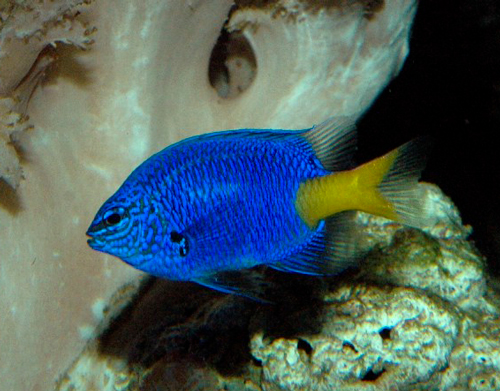
- Quick Info: Very hardy, comes in lots of colors
- Scientific Name: Chrysiptera
- Care Level: Easy
- Minimum Tank Size: 30 gallons
- Diet: Omnivore
- Temperament: Semi-aggressive
Many saltwater fish require large tanks such as 100 gallons or more, which can be overwhelming for a beginner. That is what makes the Damselfish such a good choice, as they only require a minimum tank of 30 gallons. They are also very hardy.
Damselfish can be a slightly aggressive, so give them plenty of hiding places and they will tend to keep to themselves. There are also plenty of beautiful color varieties to choose from.
3. Green Chromis
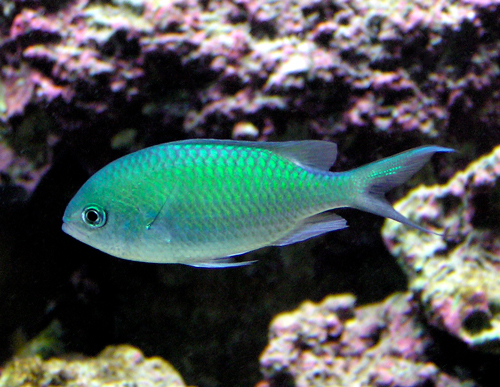
- Quick Info: Inexpensive, hardy, colorful, like to school
- Scientific Name: Chromis Viridis
- Care Level: Easy
- Minimum Tank Size: 30 gallons
- Diet: Omnivore
- Temperament: Peaceful
A mellow fish, the Green Chromis is easy to care for and makes a great addition to a new saltwater aquarium. It is an active schooling fish and enjoys an aquarium with plenty of live rock.
The Green Chromis will look great in a well-lit aquarium, especially if it is schooling. Best of all, they are a hardy and colorful; a great combination for the beginner saltwater fish keeper.
4. Cardinalfish
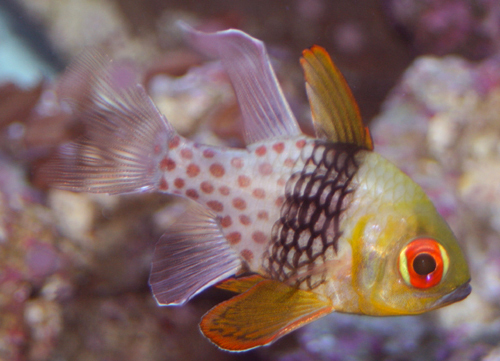
- Quick Info: Inexpensive, hardy, like to school
- Scientific Name: Apogonidae
- Care Level: Easy to Moderate
- Minimum Tank Size: 30 gallons
- Diet: Carnivore
- Temperament: Peaceful to Semi-aggressive
The Cardinalfish is one of the more unique looking choices and comes in different varieties such as the Pajama Cardinal and Bangaii Cardinal. The recommended aquarium size for this fish is 30 gallons (especially for schooling).
The Cardinalfish tend to keep to themselves and will be most active at night. They like having plenty of places to hide during the day so make sure you give them live plants and rocks to explore.
5. Bicolor Blenny
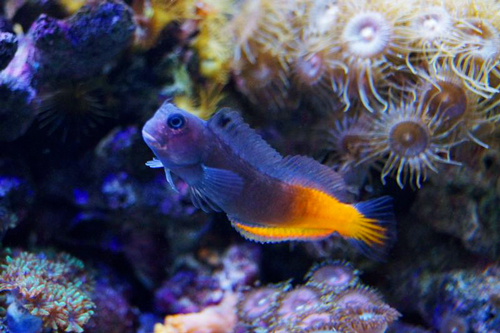
- Quick Info: Peaceful, hardy, inexpensive
- Scientific Name: Ecsenius bicolor
- Care Level: Easy
- Minimum Tank Size: 30 gallons
- Diet: Herbivore
- Temperament: Peaceful
The Blenny is not only a beautiful fish, but it is also great for beginners because they’re so peaceful. They spend most of their time hiding among the rocks and plants, occasionally peeking out to observe their surroundings.
Although Blennies get along with other fish, they will fight among themselves so it is best to only add one to your aquarium.
6. Clown Goby
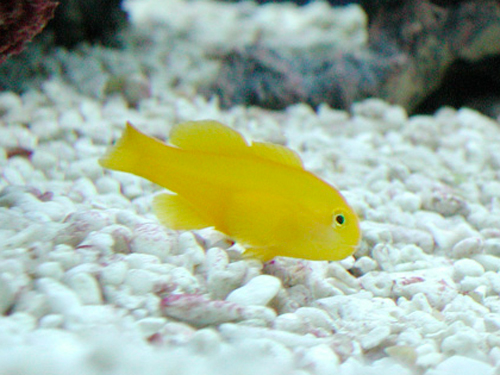
- Quick Info: Inexpensive, hardy, comes in many colors
- Scientific Name: Gobiodon
- Care Level: Easy
- Minimum Tank Size: 10 gallons
- Diet: Carnivore
- Temperament: Peaceful
The Clown Goby is a great addition to any saltwater aquarium because it is peaceful, comes in many vibrant colors, is inexpensive, and is hardy.
Often seen perched on live rock or coral, it will make a wonderful addition to any reef aquarium with colonies of polyp corals. Be careful if you place it with SPS corals though, since the Clown Goby may nip at the smaller polyps.
Although the Clown Goby will get along with other fish, they will fight among themselves so it is best to keep it with other docile species.
7. Yellow Watchman Goby
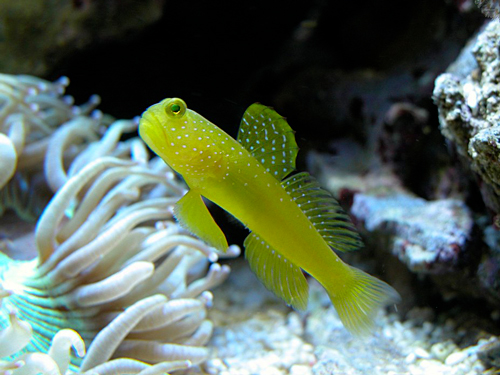
- Quick Info: inexpensive, hardy, colorful
- Scientific Name: Cryptocentrus cinctus
- Care Level: Easy
- Minimum Tank Size: 30 gallons
- Diet: Carnivore
- Temperament: Peaceful
The Yellow Watchman Goby is one of the best fish for saltwater aquarium beginners because they are not picky about their diet and will eat food readily available at the pet store, are inexpensive, and hardy. Goby fish are also popular, so they are easy to find in many pet stores.
The Watchman Goby is peaceful and gets along with other fish but does not get along well with other Gobies, so make sure you keep them separated if you get more than one.
8. Firefish Goby
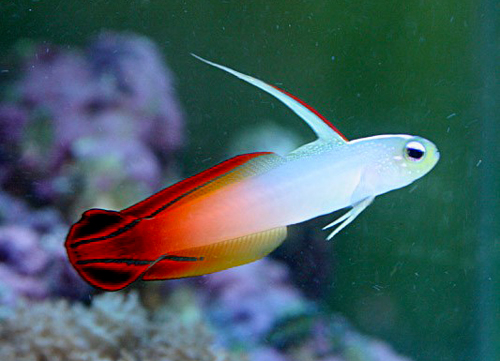
- Quick Info: Hardy, doesn’t need a big tank
- Scientific Name: Nemateleotris Magnifica
- Care Level: Easy
- Minimum Tank Size: 20 gallons
- Diet: Carnivore
- Temperament: Peaceful
Another gorgeous Goby for saltwater beginners, the Firefish is a long, thin fish generally with a light-colored body and a red, orange, and/or magenta tail (which is how they got their name)
The Firefish Goby has a peaceful temperament, which is a great choice for community aquariums. They are calm, non-confrontational, and will eat almost anything. They are also fun to watch because they move fast and like to hide.
9. Hawkfish
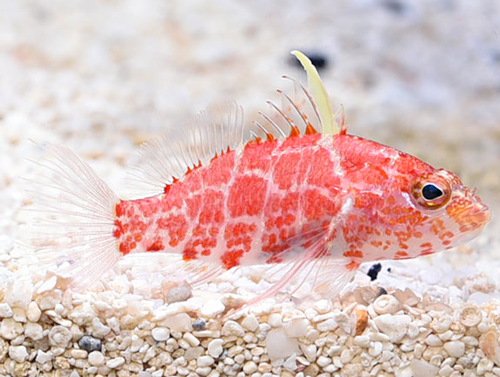
- Quick Info: Hardy, doesn’t need a big tank
- Scientific Name: Cirrhitidae
- Care Level: Easy
- Minimum Tank Size: 30 gallons
- Diet: Carnivore
- Temperament: Aggressive
The Hawkfish comes in different varieties and has an interesting look that adds interest to any saltwater aquarium. It is also another hardy fish, making it a good choice for saltwater beginners. Be sure to have a tight-fitting lid though, because these fish are known to be escape artists.
This species is also aggressive, and may harass small, peaceful fish and most other fish introduced to the aquarium after it has been established. Its tank mates should be larger than itself and semi-aggressive, and with proper caution, be compatible in a reef environment.
10. Lawnmower Blenny
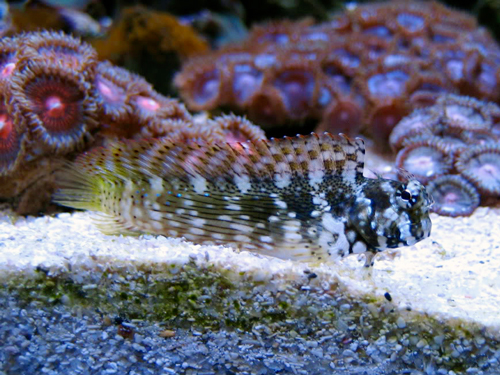
- Quick Info: Eats algae, inexpensive, hardy
- Scientific Name: Salarias fasciatus
- Care Level: Easy to Moderate
- Minimum Tank Size: 30 gallons
- Diet: Herbivore
- Temperament: Peaceful
The Lawnmower Blenny is a peaceful and active fish. It’s also inexpensive and hardy; making it a good choice for beginner marine aquarists. Its mottled tan color, oversized eyes, and typical body shape of the Blenny family adds visual appeal to any saltwater aquarium.
Like other Blennies, it will perch on live rock, hide in caves, and hop across substrate. It also helps keep your aquarium clean by eating algae.
The Lawnmower Blenny is peaceful towards other tank mates unless they are similar in shape or appearance to a Blenny, therefore it is best have an individual Blenny unless kept in a larger aquarium and the two are a mated pair. Use caution when placed with Coral as it is known to nip at small-polyped stony coral and clam mantles.
11. Diamond Goby
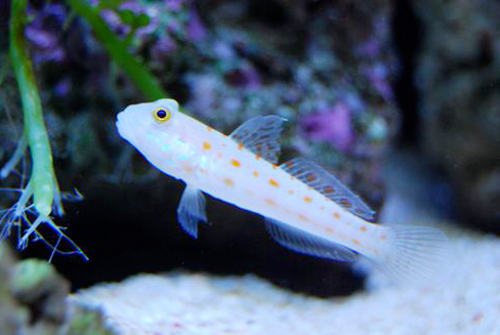
- Quick Info: Hardy, cleans sand
- Scientific Name: Valenciennea puellaris
- Care Level: Easy
- Minimum Tank Size: 30 gallons
- Diet: Carnivore
- Temperament: Peaceful
The Diamond Goby can be a timid fish, but makes a great addition to a reef aquarium because of its longevity, hardiness, and it helps clean sand.
It is best in a 30 gallon or larger aquarium with live sand as the substrate, because it uses shallow burrows in the substrate as a refuge, which keeps the substrate well oxygenated. The Diamond Goby is rarely becomes aggressive towards other fish, but can be territorial and will fight with its own kind unless they are a mated pair.
12. Six Line Wrasse
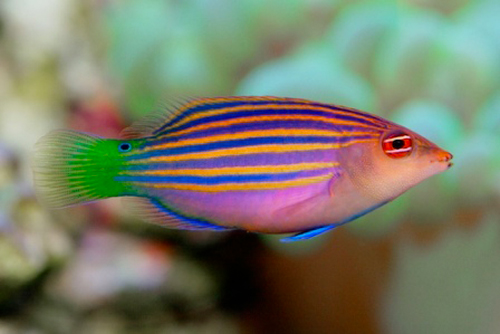
- Quick Info: Inexpensive, colorful
- Scientific Name: Pseudocheilinus hexataenia
- Care Level: Easy
- Minimum Tank Size: 55 gallons
- Diet: Carnivore
- Temperament: Semi-aggressive
The Six Line Wrasse is inexpensive, colorful, and active; making it a great addition to the beginner’s marine aquarium. It requires a peaceful environment with a good amount of hiding places and live rock on which they can forage.
The Six Line Wrasse is generally peaceful but may act aggressively towards other Wrasses and other easily-intimidated fish. This is especially true if it is not adequately fed or if its habitat doesn’t have places in which to hide.
13. Royal Gramma
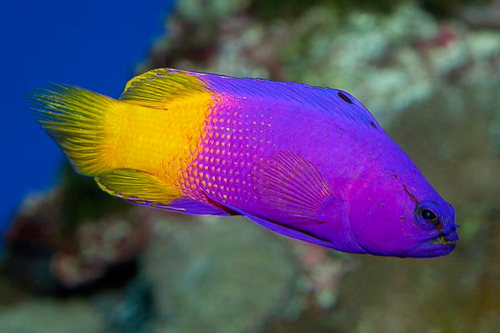
- Quick Info: Inexpensive, hardy
- Scientific Name: Gramma loreto
- Care Level: Easy
- Minimum Tank Size: 30 gallons
- Diet: Carnivore
- Temperament: Peaceful
The Royal Gramma is an inexpensive fish and adds a nice burst of color to any saltwater aquarium. Due to its unique color pattern and smaller adult size, the Gramma is a good beginner fish for nano reef systems. It also prefers rockwork in which to hide and somewhat subdued lighting.
While they get along well with most aquarium mates of similar size and temperament, the Royal Gramma will get territorial with its own kind; so having just one in your aquarium is best.
14. Coral Beauty Angelfish
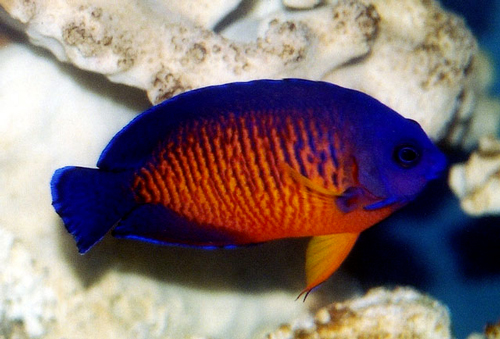
- Quick Info: Hardy, colorful
- Scientific Name: Centropyge bispinosa
- Care Level: Easy
- Minimum Tank Size: 70 gallons
- Diet: Omnivore
- Temperament: Semi-aggressive
If you want to start out with a larger saltwater aquarium, at 70 gallons or more, the Coral Beauty Angelfish is a great addition because it is hardy and colorful. It can also do fine individually or in small schools.
Although Coral Beauties don’t require coral in an aquarium, they do need lots of hiding places and live rock for grazing. It is also prone to nip at stony and soft corals so use caution if you plan to put it in a reef aquarium.
15. Rusty Angelfish
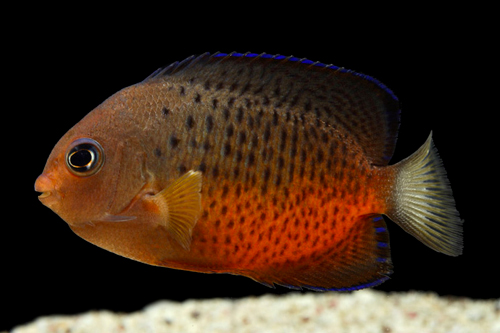
- Quick Info: Hardy, colorful
- Care Level: Moderate
- Minimum Tank Size: 70 gallons
- Diet: Omnivore
- Temperament: Semi-aggressive
The Rusty Angelfish is named after its red/amber coloration with black dots. Even though their care level is listed as moderate, they are a hardy and colorful fish.
However, this fish requires at a minimum a 70 gallon tank with large amounts of live rock for hiding and grazing. Use caution if placing it within a reef tank, though, as the Rusty Angelfish is known to nip at stony and soft corals and clam mantles.
16. Dottyback
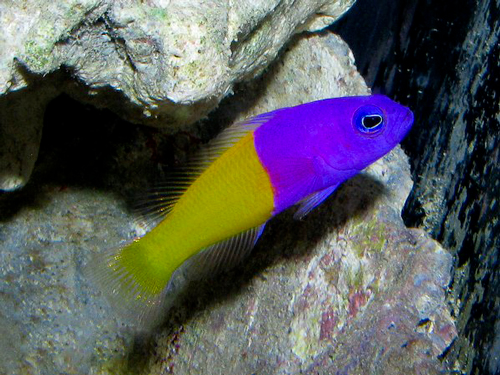
- Quick Info: Hardy, comes in different colors
- Scientific Name: Pseudochromidae
- Care Level: Easy
- Minimum Tank Size: 30 gallons
- Diet: Carnivore
- Temperament: Semi-aggressive
Another good choice for the beginner saltwater enthusiast, the Dottyback is a hardy fish that comes in various colors including blue, purple, and yellow as well as bicolor that are half yellow and half purple.
This fish will need a minimum aquarium size of 30 gallons. The Dottyback can be aggressive, but with the correct tank size, plenty of hiding spots, and a good diet, they’re typically happy and non-confrontational.
17. Chalk Bass
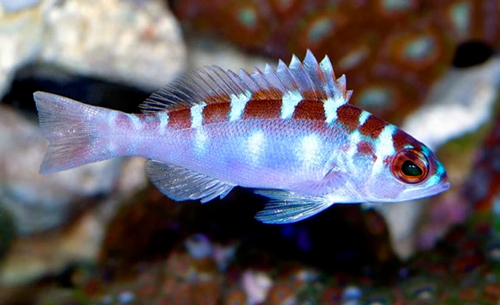
- Quick Info: Small, hardy, colorful
- Scientific Name: Serranus tortugarum
- Care Level: Easy
- Minimum Tank Size: 30 gallons
- Diet: Carnivore
- Temperament: Semi-aggressive
A very hardy, colorful, and small fish, the Chalk Bass is a great saltwater fish for beginners.
It is durable and can even live in less than optimal water conditions, which when you’re just starting out, having a tolerant fish like a Chalk Bass makes it easier to learn proper care.
Several Chalk Bass can live in the same aquarium, but it’s important to introduce them all at the same time to avoid territorial fighting within the species. A 30 gallon aquarium with abundant live rock for hiding is ideal for the Chalk Bass. It will also not pick at corals or sessile invertebrates and are a great fish for a reef aquarium.
18. Yellow Coris Wrasse
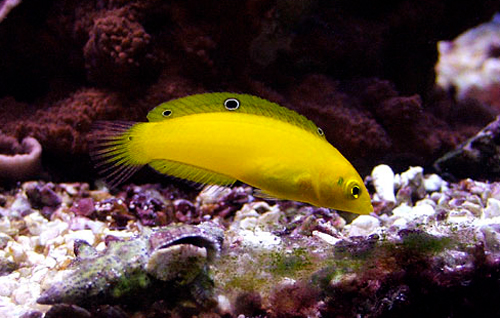
- Quick Info: Small, hardy, active
- Scientific Name: Halichoeres chrysus
- Care Level: Easy to Moderate
- Minimum Tank Size: 50 gallons
- Diet: Carnivore
- Temperament: Peaceful
The Yellow Coris Wrasse, also referred to as a Golden Rainbowfish, Golden Wrasse, or Canary Wrasse, is another hardy and small fish good for beginners.
Although a smaller saltwater fish, the Yellow Coris Wrasse is active and should have a tank size of 50 gallons or larger with a sealed lid. A sandy substrate of 2-3 inches to hide under when frightened should also be included.
The Yellow Coris Wrasse is peaceful and will generally get along with other peaceful Wrasse, including its own species. It will also protect corals and clams by eating fireworms and pyramidellid snails as well as eat parasites off tank mates.
19. Green Coris Wrasse
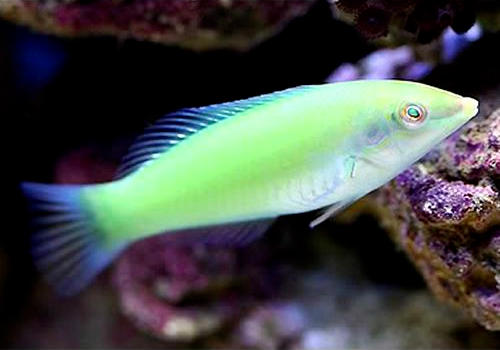
- Quick Info: Small, hardy, active
- Scientific Name: Halichoeres Chloropterus
- Care Level: Moderate
- Minimum Tank Size: 75 gallons
- Diet: Carnivore
- Temperament: Peaceful
The Green Coris Wrasse, also referred to as a Pastel Green Wrasse, is a hardy and small fish good for beginners. Although a smaller saltwater fish, the Green Coris Wrasse is active and should have a tank size of 75 gallons or larger with a sealed lid and a sandy substrate of 2-3 inches to hide under when frightened.
The Green Coris Wrasse is peaceful and will generally get along with other peaceful Wrasse, including its own species. It will also protect corals and clams by eating fireworms and pyramidellid snails as well as eat parasites off tank mates.
20. Bicolor Angelfish
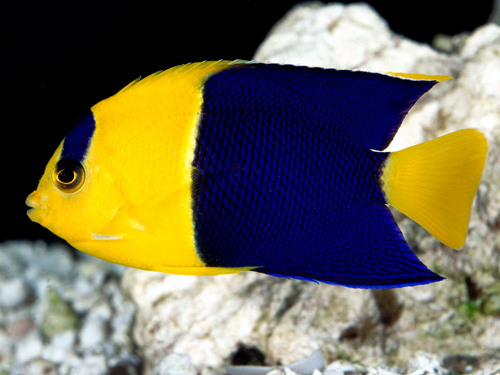
- Quick Info: Hardy, colorful
- Scientific Name: Centropyge bicolor
- Care Level: Moderate
- Minimum Tank Size: 70 gallons
- Diet: Omnivore
- Temperament: Semi-aggressive
The Bicolor Angelfish, also known as a Two-colored Angelfish or Oriole Angelfish, is a hardy fish with yellow on the first half of its body and blue on the second half.
A 70 gallon tank with plenty of hiding places and live rock for grazing is best for this Angelfish. However, the Bicolor Angelfish is not a good reef dweller because it is prone to nip at stony and soft corals and clam mantles.
3 Ways to Introduce New Saltwater Fish into an Aquarium
When adding fish to your new or established saltwater aquarium, there are a few ways to do it safely and without causing stress to your newest addition.
1. Drip Acclimation
Drip acclimation is considered the safest way to add fish to your aquarium. For drip acclimation you will need a clean bucket, a piece of tubing that can reach from inside the tank to the bucket, and some way to secure the tube in place.
First, take the bag your fish came in and either place it in its entirety in the bucket, or if there is enough water in the bag, you can empty it (fish and all) into the bucket. If you use the bag, poke a hole in the top to be able to insert the tubing.
Next, you’ll want to start a siphon so the water from your aquarium drips into the bag or bucket at about one drop per second. Once the volume of water in the bucket reaches about twice what you began with, remove half the water, and let it fill back up again.
Once the water fills back up test the pH and salinity of both the aquarium water and water in the bucket. If they match you can add the fish to the aquarium. Otherwise, repeat the process and test the water again.
Drip acclimation is considered the safest way because it allows the water from the aquarium to slowly mix with the water the fish came in, which will let the fish acclimate to the new water without placing it inside the tank right way.
2. Floating Bag
The floating bag method is commonly used for freshwater fish, but it also works with saltwater fish. The floating bag method is a little riskier because you don’t have a separation between your aquarium and the new fish like you do with the drip method, which means it could cause problems if the new fish is contaminated.
First, open the bag and remove about a quarter of the water and replace it with aquarium water. Then close the top of the bag again and let it float in the aquarium. Add another cup of aquarium water every fifteen minutes. Do this until the bag is full.
Once the fish has had an hour to acclimate to the changes you can add it to the aquarium. It is best to use a net when adding the fish to the aquarium because it is safer than simply dumping the whole bag. Using a net keeps the water that came from the pet store out of aquarium in case it is contaminated.
3. Bucket Acclimation
The next method is bucket acclimation. This is the same as the floating bag method; except done in the bucket instead of the aquarium. This way is a little less risky because the process is done away from your aquarium, thereby lessening the chance of contaminating the aquarium water.
First, place some aquarium water in the bucket. Then follow the same method as the floating bag steps, only floating the bag in the bucket instead of inside the aquarium.
Other Considerations
When building a saltwater aquarium community from scratch it is best to start with the least aggressive fish. Then add one type of fish at a time; letting them get used to each other before adding the more aggressive fish.
Another thing to consider when adding new fish to any aquarium is using a quarantine tank. A quarantine tank is an empty, cycled tank that you can put new fish in and watch them for a few weeks before adding them to your aquarium. This way, you can ensure they aren’t sick or contaminated and as a result, won’t harm the rest of the fish in your aquarium.
Final Thoughts
While saltwater aquariums are higher maintenance than freshwater aquariums, choosing the correct fish will make the process easier and leave room to learn from minor mistakes. If you are still feeling unsure about the maintenance, consider our maintenance and service plans.


